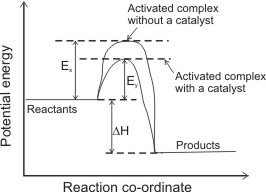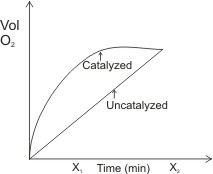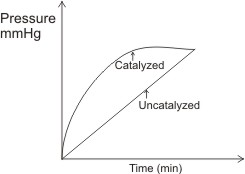|
Home
Catalysts and Chemical Reactions
Definition of Catalyst - a catalyst is a substance which, although often present in small proportions, increases the rate of a chemical reaction, but remains chemically unchanged at the end of the reaction.
Properties of a Catalyst
In an energy profile diagram, the use of catalysts is indicated by a lower curve.

From the diagram above, Ex represents activation energy without a catalyst, Ey - activation energy with a catalyst.
Note: the use of catalyst does not change or affect the
enthalpy (∆H) of reactions, it only increases their speed.
-
In a reversible reaction, a catalyst does not affect the position of equilibrium, i.e., it does not determine which side is
favored, it only helps to quickly make possible a reaction which is favored by low temperature condition.
For instance, in the Haber process, lowering the temperature will favor the forward reaction, i.e., the production of ammonia. However, the reaction will be so slow because of the very high activation energy involved.
The use of reduced iron as catalyst will only help to reduce the
activation energy, and therefore quicken the reaction. In this case, it is change in temperature that affects equilibrium position, not the use of catalyst.
-
The physical state of a catalyst may change in a reaction, but its chemical nature is not affected.
-
A catalyst will function in a reaction even if it is present in minute or small proportions.
-
A catalyst is reaction specific, i.e., a substance that might act as a catalyst in one reaction might not be a catalyst in another reaction. Example, in the laboratory preparation of oxygen from potassium chlorate.
Manganese(IV) oxide acts as catalyst, but in the preparation of chlorine from hydrochloric acid, marganese(IV) oxide is actually one of the reactants and not a catalyst.
-
A catalyst does not affect either the
enthalpy of a reaction or the
free energy of a system.
The presence of other substances may increase or decrease the efficiency of a catalyst. Example, Alumina when added to iron in the Haber process (for the manufacture of ammonia) increases the efficiency of iron.
Substances which increase the efficiency of catalysts are called promoters, while those which decrease it are known as inhibitors or catalyst poison - example, the addition of arsenic compounds decrease the efficiency of the platinum used in
catalyzing the conversion of SO2 to SO3.
Some reactions which occur at their normal rate may be slowed down or stopped completely by the addition of other substances. Such substances are called Negative Catalysts.
Example, about 2% ethanol in trichloromethane acts as negative catalyst against the oxidation of trichloromethane by the air to poisonous products. Phosphoric(V) acid decreases the rate of decomposition of hydrogen peroxide, H2O2. The above table gives examples of catalysts for some common reactions.
Effect of Catalysts in Chemical Reactions
The effect of catalysts in chemical reactions can be illustrated by the thermal decomposition of potassium trioxochlorate(V) using manganese(IV) oxide:
2KClO3(s) → 2KCl(s) + 3O2(g)
The reaction produces oxygen which is confirmed by the rekindle of a glowing splint inserted into the reacting vessel. Three ignition tubes are used: in one is a mixture of manganese(IV) oxide and potassium trioxochlorate (V);in the other two are manganese(IV) oxide and potassium trioxochlorate(V) respectively.
The ignition tubes are heated for some time. On observation of the tubes, it would be found that after about one minute, only the tube with the mixture of manganese(IV) oxide and potassium trioxochlorate(V) underwent a change (i.e. gave off oxygen).
The mass of MnO2 remained constant after the reaction, indicating that the oxygen produced is from potassium trioxochlorate(V) and not from MnO2. The content of the other two tubes would show no change.
The effect of mnO2 in the first tube therefore is that it enables KClO3 to decompose into KCl and oxygen in a short time. The increasing volume of oxygen produced with time can be used to determine the rate of the reaction, i.e. how well the catalyst has affected the reaction.
The graph of volume of oxygen produced with time is :

Note: At the end of the reaction, the volume of oxygen produced remained constant with time.
From the curve, using a catalyst enables the reaction to complete in X1 time instead of X2 time (without using a catalyst).
The steepest slope on the curve gives the rate of the reaction. Increase in pressure, resulting from increase in volume of oxygen can also be used to measure the rate of reaction.

Below are Some Catalysts and the Reactions
they Affect
| Catalyst |
Reaction |
|
1. Manganese(IV) oxide, MnO2 |
Production of oxygen from heating potassium
trioxochlorate(V), 2KClO3(s) → 2KCl(s) + 3O2(g) |
2. Vanadium(V) oxide or platinum
(powder) |
Oxidation of sulphur(IV) oxide to sulphur(VI)
in the
contact process for the manufacture of H2SO4,
2SO2(g) +
O2(g)
 2SO3(g) 2SO3(g)
|
| 3. Reduced iron (powder) |
Haber process - manufacture of ammonia,
N2(g) + 3H2(g) 2NH3(g) 2NH3(g)
|
4. Manganese(IV) oxide, MnO2
or
platinum powder
|
Production of oxygen from decomposition of
hydrogen peroxide, 2H2O2(aq) → 2H2O(l) + O2(g)
|
| 5. Nickel |
Complete reduction of ethyne to ethane by
hydrogen,
C2H2(g) + 2H2(g) → C2H6(g)
|
6. Zymase (enzyme - organic catalyst)
|
Conversion of sugar into alcohol,
C6H12O6(aq) → 2C2H5OH(aq) + 2CO2(aq)
|
7. Diastase (enzyme)
|
Hydrolyses of starch to sugar,
2C6H10O5(aq)
+ H2O(l) → C12H22O11(aq) |
|

